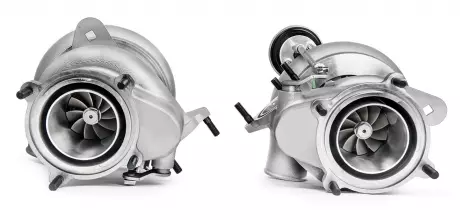Technology explained - twin turbos

Porsche has used twin turbochargers on its 911 since the 1990s, but how do these devices manage to generate such significant power gains?
Turbo charging has been utilised by Porsche since 1973, where it was put to devastating effect in the 1974 Carrera RSR 2.1. Quick to make use of the technology in production cars, the 3.0-litre engined Turbo (930) was launched in 1974.
An efficient way of permitting extra fuel to be combusted, the turbo forces compressed exhaust gas back into the engine intake. The amount of fuel that can be combusted is limited by the amount of air in the cylinder. Increase the air volume, and this extra air means fuelling can be increased, in turn raising the output of the engine.
This is the single turbo application, used by Porsche in all 911 Turbo models from 1974 up to that of the 964’s 3.6-litre flat six. However, turbocharging like this required a choice; what size turbo to use? Each offered alternate benefits. The smaller unit will spool up rapidly, but quickly reach its output, negating the benefits at the top end. A larger unit offers greater top-end performance, but takes a long time to ‘spool up’. This is the lag before the boost that the 930 is famous for.
Having succeeded in a single turbo application, Porsche moved to twin turbos, notably with the 935/77. This featured a 2.8-litre flat six fed by twin KKK turbos – one for each cylinder bank to dramatically reduce turbo lag. Rabid race cars are one thing, but docile consumer alternatives would take a while to follow. It would be a full decade later before twin turbos appeared in a production 911: the iconic 959.
Twin turbos offer a number of ways of operating, but principally being either parallel, or sequential. In parallel, the pair spool up together, delivering the same amount of boost, but equally suffering the same issues around turbo lag. One turbo per cylinder bank mitigates a little of this, but not totally.
For the 959 they came up with a way to get the best of both turbo worlds. A small turbo could spool up quickly for lower-end benefit, then a larger turbo could give a hefty kick at the top end. This is a sequential twin turbo setup, and the 959 required a complex system of valves and electronic controls to harness the benefits effectively. Nonetheless, it proved the merits of such a setup, despite the engineering effort required.
The factory introduced twin turbos on the 993 Turbo, where they worked in parallel to feed the 3.6-litre motor. For production reliability and simplicity, two small turbos were used, carefully balancing low- and top-end performance, for a hefty 408bhp.
As technology moved on, turbos incorporated variable turbine geometry (VTG). VTG means the turbo produces boost over a larger rev range, bypassing the complexities a sequential system entails. The 997 Turbo was the first 911 to use twin VTG turbos, and they’ve been used on all generations of 911 Turbo since. Thanks to VTG, they operate in parallel.

